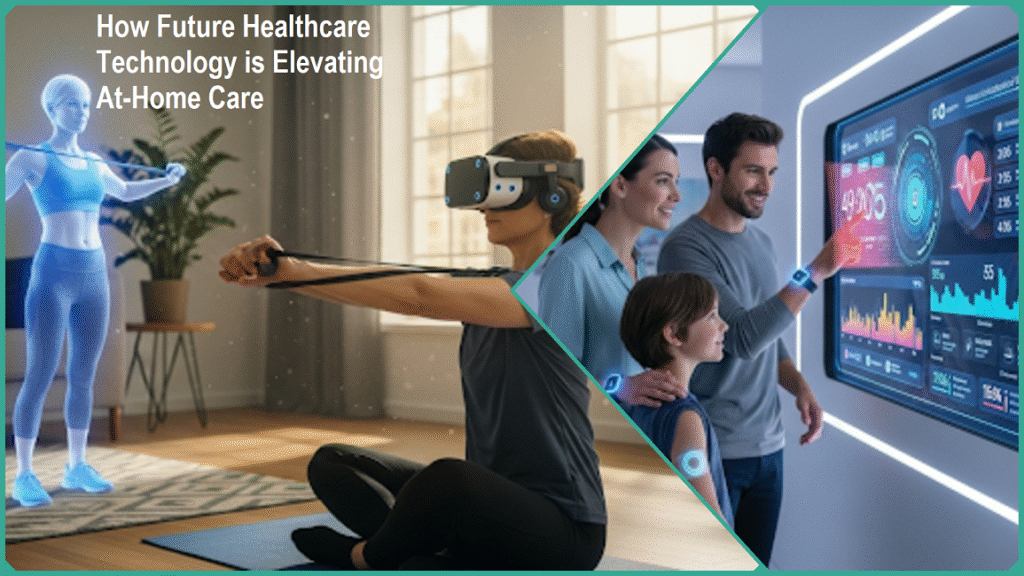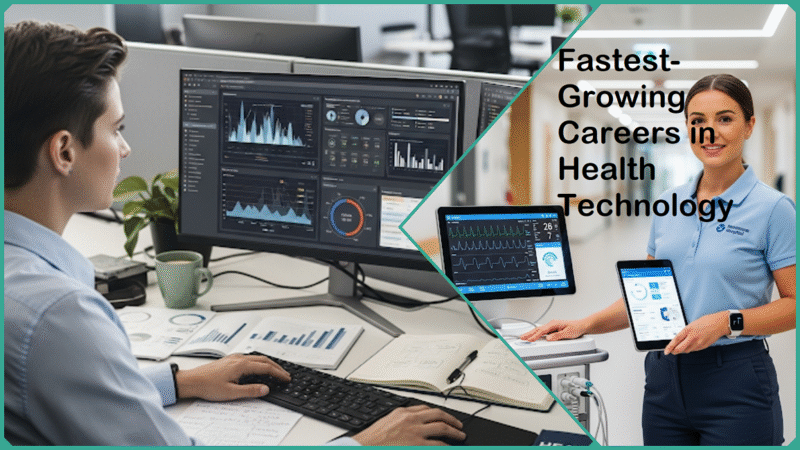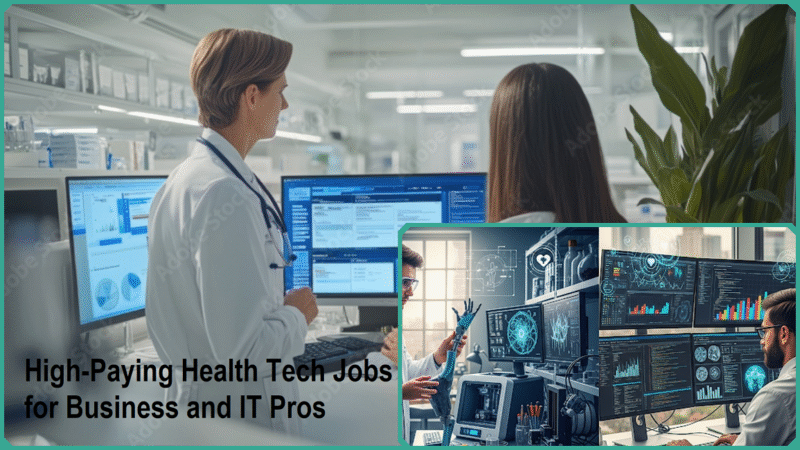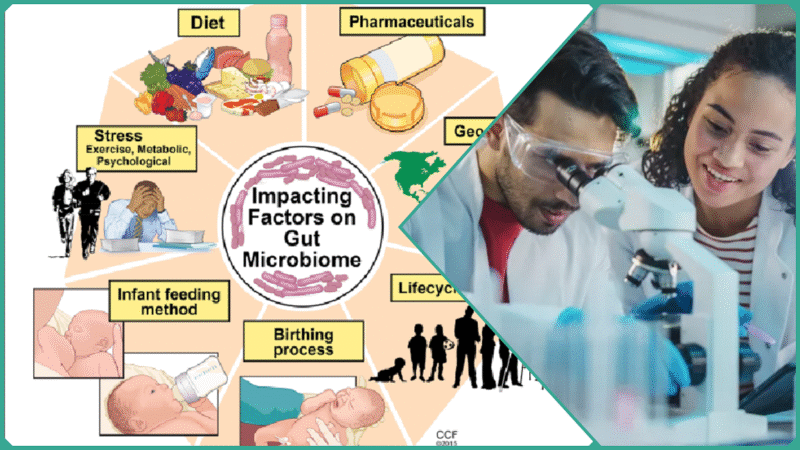How Future Healthcare Technology is Elevating At-Home Care
Estimated reading time: 24 minutes
The healthcare landscape has undergone a significant transformation, with a pronounced shift towards at-home care in recent years. This evolution is driven by rising healthcare costs, an aging population, and patients’ growing preference for personalized, comfortable treatment outside of traditional settings.
Future healthcare technology is now at the forefront of this shift, elevating the quality, accessibility, and efficiency of care delivered in homes. For healthcare organizations, professionals, software developers, and decision-makers, understanding these innovations is crucial to optimizing patient outcomes and operational efficiency.

This article explores how emerging technologies—including artificial intelligence (AI), telehealth, wearable biosensors, and advanced software solutions—are revolutionizing at-home care. We discuss key concepts, current trends, practical applications, benefits, challenges, and actionable strategies. We also highlight the vital role custom healthcare software development plays in supporting these advancements and improving workflows.
Key Concepts and Theories in Future Healthcare Technology for At-Home Care
The fundamental concepts and foundational theories in the field of future healthcare technology aimed at significantly enhancing at-home care revolve around several deeply interconnected and evolving areas.
Each of these areas plays a crucial role in revolutionizing the way medical support and healthcare services are provided beyond the traditional clinical and hospital environments, fundamentally changing patient experiences and outcomes outside conventional settings:
- At-Home Care Defined: At-home care involves medical and supportive health services provided in patients’ residences rather than hospitals or clinics. This encompasses a wide range of care, including routine monitoring of chronic illnesses, post-acute rehabilitation, mental health support, and eldercare. The goal is to offer more comfortable, accessible, and patient-centric healthcare experiences at home.
- Patient-Centered Care Model: This model prioritizes tailoring healthcare delivery to individual patients’ preferences, health conditions, and social environments. Advanced technologies facilitate this personalization by enabling continuous data collection from patients and interactive communication channels between patients and providers, thus improving engagement and outcomes.
- Telehealth and Virtual Care: Telehealth uses digital platforms like video calls and mobile apps to offer real-time remote consultations and monitoring. This reduces barriers related to location and mobility, decreases the need for physical visits, and extends healthcare access, especially important in rural or underserved areas. The rising integration of immersive technologies such as virtual reality is enhancing telehealth applications, notably in physical therapy and mental health.
- Artificial Intelligence (AI) and Machine Learning (ML): AI and ML analyze vast amounts of healthcare data from wearable sensors and electronic health records (EHRs) to detect trends, predict potential health issues before they become critical, and support clinical decisions. AI also automates administrative workflows and helps customize treatment plans for individual patients.
- Wearable Biosensors: These are devices worn by patients that continuously monitor vital physiological parameters like heart rate, blood glucose, blood pressure, and oxygen saturation. The real-time data they generate supports timely clinical interventions and helps prevent complications.
- Custom Healthcare Software: Customized digital platforms serve as comprehensive solutions to coordinate care, streamline administrative tasks like scheduling and documentation, deliver data analytics, and enhance patient engagement via user-friendly portals. These platforms integrate multiple functionalities—EHR access, remote monitoring data, communication tools, compliance reporting—into a single seamless system.
Emerging healthcare technology trends in 2025 continue to strongly reinforce and significantly expand upon these foundational concepts, bringing innovations and advancements that further transform the industry.
These trends not only build on the existing principles but also introduce fresh approaches and tools that enhance healthcare delivery, patient outcomes, and operational efficiencies. By integrating cutting-edge technologies and leveraging data-driven insights, the healthcare sector is poised to evolve in ways that deepen the impact of these core concepts well into the future.
- The proliferation of 5G-enabled medical devices facilitates ultra-low latency communications, enabling real-time remote surgery, high-definition telehealth consultations, and seamless integration of Internet of Medical Things (IoMT) devices, vastly improving remote patient monitoring.
- AI-driven diagnostics and personalized treatment plans improve accuracy and efficiency across healthcare.
- Advanced wearable health devices now provide clinical-grade monitoring beyond fitness tracking, including continuous glucose monitoring via smart contact lenses and real-time cardiac monitoring.
- Automation extends into healthcare administration, reducing burdens on providers and enabling caregivers to focus more on patients.
These technologies collectively underscore a shift towards more accessible, personalized, efficient, and proactive care in home settings, addressing critical challenges such as workforce shortages, rising costs, and patient demand for convenience without compromising care quality.
In Summary
Future healthcare technology designed for at-home care seamlessly integrates patient-centered care principles with a wide range of robust digital tools—including telehealth platforms, advanced artificial intelligence, sophisticated wearable biosensors, and highly tailored software solutions.
Together, these elements create a comprehensive ecosystem that supports effective, continuous, and deeply personalized healthcare delivery outside of traditional clinical and institutional settings. This advanced integration is poised to significantly transform healthcare accessibility, greatly enhance operational efficiency, and improve patient outcomes in profound ways over the coming years.
Current Trends and Developments Elevating At-Home Care
Current trends and developments prominently elevating the field of at-home care increasingly feature the seamless integration of advanced AI technologies and state-of-the-art wearable devices, alongside the rapid expansion of telehealth services enhanced by immersive virtual reality (VR).
Additionally, the adoption of automation tools aimed at optimizing workflow efficiency, the application of sophisticated data analytics to deliver highly personalized care experiences, and the implementation of comprehensive workforce management solutions are playing pivotal roles.
Here is a detailed and thorough review of each of these significant trends, grounded in the latest research findings and valuable industry insights:
Integration of AI and Wearable Devices for Continuous Monitoring
The combination of AI and wearable biosensors is revolutionizing chronic disease management at home. Wearables—such as smartwatches, continuous glucose monitors (CGMs), ECG patches, and other biosensors—continuously collect vital signs like heart rate, blood glucose, blood pressure, oxygen saturation, physical activity, and sleep data.
AI algorithms meticulously analyze these vast, real-time datasets to identify even the most subtle changes in health status, accurately predict the likelihood of disease exacerbations, and promptly generate timely alerts that enable early intervention and proactive management of patient conditions.
- This technology reduces hospital admissions by enabling proactive care. For example, AI can forecast diabetic crises or detect cardiac arrhythmias before they manifest critically, allowing clinicians to intervene earlier.
- Personalized treatment plans are derived from AI’s ability to analyze individual health trends, adjusting medication or therapy dynamically.
- Patients experience fewer clinic visits and improved self-management supported by continuous health insights.
- Challenges such as data privacy, device accuracy, and integration with clinical workflows are actively addressed in ongoing development.
Recent studies have increasingly confirmed that AI-powered wearable devices play a crucial and significantly influential role in reducing hospitalization rates and enhancing overall health outcomes for individuals suffering from chronic diseases. These chronic conditions include, but are not limited to, diabetes, cardiovascular diseases, and various respiratory illnesses.
The integration of AI technology in wearable health devices allows for continuous monitoring, early detection of potential complications, and more personalized treatment plans, thereby contributing substantially to better management of these long-term health issues.
Telehealth Expansion and Virtual Reality (VR) for Enhanced Engagement
Telehealth usage experienced an unprecedented surge of over 300% during the COVID-19 pandemic, fundamentally transforming how healthcare services are delivered to patients. This rapid increase in adoption has not only accelerated during the pandemic but continues to grow steadily, establishing telehealth as a critical and integral mode of healthcare delivery worldwide.
In response to this growing demand, advanced telehealth platforms are evolving by increasingly integrating cutting-edge immersive technologies, including virtual reality (VR), to significantly enhance patient engagement and improve the overall quality of care provided. These innovations aim to create more interactive, personalized, and effective healthcare experiences for patients across various medical fields.
- VR applications support physical therapy by creating interactive, motivating rehabilitation environments at home.
- Mental health treatment benefits from VR’s immersive exposure therapy and relaxation techniques.
- Telehealth reduces barriers related to geography and mobility and provides timely access to specialists.
This seamless integration results in significantly improved patient adherence to prescribed treatments and overall satisfaction, thereby making remote healthcare services far more effective and considerably more patient-friendly in their approach.
Automation and AI-Powered Workflow Optimization
Home care providers are currently confronting significant workforce shortages along with escalating demands for their services, creating an urgent need to implement substantial efficiency improvements. These challenges are putting increasing pressure on the industry to find innovative solutions that can help manage resources more effectively while still meeting the growing care requirements of their clients.
- AI streamlines administrative functions—scheduling, documentation, visit verification, billing—freeing caregivers from paperwork.
- Chatbots powered by AI assist in caregiver onboarding, training, and communication.
- Automation enhances compliance with regulatory requirements by ensuring accurate and timely documentation.
These improved efficiencies enable caregivers to devote significantly more time and attention to direct patient care, which in turn enhances the overall quality of care provided. This increased focus on patient interaction not only benefits the patients themselves but also leads to greater satisfaction and fulfillment among healthcare providers.
Data Analytics and Predictive Insights for Personalized Care
Sophisticated and advanced analytics platforms are designed to aggregate comprehensive patient data collected from a wide variety of sources, including wearable devices, electronic health records (EHRs), and remote patient monitoring systems.
These platforms analyze the integrated data to identify significant trends, evaluate the effectiveness of different treatment methods, and detect potential gaps in patient care, thereby enabling healthcare providers to make more informed decisions and improve overall patient outcomes.
- Predictive analytics enable providers to identify high-risk patients early and tailor interventions, improving clinical outcomes and reducing costs.
- Data-driven insights guide evidence-based adjustments to care plans in near real-time.
- Behavioral trends and treatment adherence data allow for more personalized, patient-centered care strategies.
Workforce Management Solutions to Address Labor Shortages
The anticipated significant growth in the home care workforce, with an estimated 34% increase needed by 2029 in the United States alone, highlights the urgent necessity for developing and implementing innovative support systems that can effectively address the expanding demands and challenges within this sector.
- Digital assistants and incentive point systems improve recruitment, motivation, and retention of caregivers.
- Continuous learning platforms provide accessible training and skills development.
- Performance tracking and feedback systems ensure quality care delivery and professional growth.
These innovative, technology-driven workforce strategies play a crucial role in effectively addressing ongoing labor shortages while also helping to sustain and maintain consistently high-quality home care services for individuals in need. By leveraging advanced technological solutions, these approaches not only fill gaps in the workforce but also enhance the overall delivery and reliability of care provided in home settings.
In Summary
These emerging trends collectively highlight a profound shift in the healthcare paradigm towards smart, remote, and highly personalized care delivered directly in the comfort of patients’ homes. This transformation is made possible by the integration of advanced technologies such as artificial intelligence, wearable health monitoring devices, telehealth platforms, and sophisticated intelligent software systems.
Together, these innovations not only significantly improve clinical outcomes and enhance the overall patient experience but also effectively tackle the critical operational challenges and inefficiencies that healthcare providers currently face in delivering quality care.
Benefits of Future Healthcare Technology in At-Home Care
The benefits of future healthcare technology in at-home care are not only significant but also truly transformative, profoundly impacting patients, healthcare providers, and the overall healthcare system in numerous positive ways. Here’s an in-depth and detailed look at each of the key benefits you mentioned:
Improved Accessibility
- Advanced telehealth platforms and wearable biosensors allow patients to receive continuous medical attention from virtually any location, including rural and underserved areas with limited healthcare infrastructure.
- Technology overcomes mobility challenges faced by elderly or chronically ill patients who have difficulty traveling to clinics or hospitals.
- Remote consultations and monitoring ensure timely care, reducing barriers created by distance, transportation, or physical limitations.
Cost Reduction
- Preventing avoidable hospital readmissions and emergency visits lowers acute care expenses dramatically. AI-driven early warning systems detect deterioration before symptoms worsen, enabling interventions at home.
- Optimized use of resources through automation streamlines scheduling and reduces wasted caregiver time, cutting operational costs.
- Remote monitoring reduces the need for expensive in-person appointments and diagnostic testing by enabling continuous data collection and virtual assessments.
- Overall, healthcare organizations save by shifting care delivery from costly institutional settings to efficient, technology-supported home environments.
Enhanced Patient Experience
- Personalized care plans based on real-time data from wearable devices and AI insights allow treatments tailored to individual needs, preferences, and lifestyles.
- The comfort and familiarity of being cared for in one’s own home promote better adherence to treatment regimens and mental well-being.
- Interactive telehealth interfaces and virtual reality tools improve engagement, making care feel more interactive and supportive.
Operational Efficiency
- Automation of administrative tasks—such as scheduling, documentation, billing, and visit verification—reduces the administrative burden on healthcare providers and caregivers.
- Custom healthcare software integrates disparate functions into unified platforms, minimizing communication gaps and simplifying care coordination among multidisciplinary teams.
- AI chatbots and digital assistants support caregiver onboarding, training, and communication workflows, further easing operational demands.
Better Outcomes
- Continuous remote monitoring through wearables ensures early detection of health status changes, facilitating rapid clinical response and preventing complications.
- Predictive analytics guide proactive adjustments to care plans, focusing resources on high-risk patients and improving overall population health management.
- Data-driven insights help providers evaluate treatment effectiveness and make evidence-based decisions, resulting in improved quality of care.
Summary of the Benefits of Future Healthcare Technology in At-Home Care
| Benefit | Impact | Technology Enablers |
|---|---|---|
| Improved Accessibility | Healthcare access anywhere, overcoming mobility/geographical barriers | Telehealth platforms, wearable sensors |
| Cost Reduction | Lower hospital readmissions, optimized resource use | AI-powered monitoring, automation |
| Enhanced Patient Experience | Tailored care plans, comfort of home, increased adherence | AI analytics, VR/interactive tools |
| Operational Efficiency | Reduced admin workload, streamlined workflows | Custom software, AI chatbots, automation |
| Better Outcomes | Early intervention, personalized treatment, fewer complications | Continuous monitoring, predictive analytics |
These benefits collectively signify a profound paradigm shift in the way healthcare is delivered, transforming at-home care from a mere option into a highly feasible and often even preferable choice for a wide range of patients and healthcare providers.
By harnessing the power of emerging and future healthcare technology tools, the system evolves into one that prioritizes the patient experience more effectively, reduces overall costs, enhances operational efficiency, and focuses intently on delivering measurable, improved health outcomes.
This transformation not only significantly improves accessibility but also fundamentally reshapes and revolutionizes the entire healthcare landscape, enabling it to better meet and address the diverse and unique needs of individuals within the comfort and familiarity of their own homes.
Role of Custom Healthcare Software Development in the Future of At-Home Care
Custom healthcare software development plays an incredibly pivotal and transformative role in shaping the future landscape of at-home care by creating a comprehensive and robust digital infrastructure. This infrastructure is designed to support and facilitate significantly better patient outcomes, improve overall operational efficiency, and streamline complex workflows.
It is meticulously tailored to address the unique and specific demands that are inherent to home healthcare environments, ensuring that care delivery is both effective and adaptive to patients’ needs in a home setting.
Here are the essential roles and numerous benefits of custom healthcare software development in significantly improving and elevating the quality of at-home care services:
- Care Coordination: Custom software acts as a centralized hub where different healthcare professionals—doctors, nurses, therapists, social workers—can securely access and update patient information. This interoperability ensures that everyone involved in a patient’s care has the latest data, which reduces errors, duplication, and delays. Such platforms often include secure messaging and task assignment features, promoting seamless communication among multidisciplinary teams even from remote locations.
- Patient Engagement: User-friendly portals and mobile apps designed with intuitive interfaces enable patients and caregivers to actively participate in health management. Features such as appointment scheduling, medication and therapy reminders, telehealth visit scheduling, and educational resources empower patients to adhere to their care plans more consistently. Moreover, interactive elements like symptom reporting and direct messaging with providers foster continuous engagement and responsiveness.
- Compliance and Reporting: Automated documentation capabilities within these platforms ensure accurate and timely recording of clinical encounters, care activities, and billing data. This automation supports compliance with healthcare regulations (e.g., HIPAA, GDPR) and quality standards by reducing manual errors and simplifying audit processes. Real-time generation of reports for regulatory agencies, insurers, and internal quality improvement initiatives becomes more efficient and transparent.
- Data-Driven Decision Making: Integration of AI-driven analytics and real-time dashboards enables healthcare providers to monitor patient progress continuously and make evidence-based decisions. Predictive insights can flag potential complications early, allowing providers to intervene proactively. Aggregated data trends also help identify population-level health patterns, guiding strategic care planning and resource allocation.
By seamlessly integrating electronic health records (EHRs), advanced remote monitoring technologies, effective communication tools, and sophisticated AI analytics into one comprehensive custom platform, innovative companies like Phenomenon Studio enable healthcare organizations to provide more coordinated, personalized, and highly efficient at-home care services.
This approach not only tackles significant challenges faced by the healthcare sector—such as critical workforce shortages and the ongoing need for cost containment—but also significantly improves patient outcomes and overall satisfaction levels, leading to a better quality of care for patients receiving treatment in their own homes.
Challenges and Tech-Driven Solutions in Future At-Home Healthcare
The shift to at-home care presents significant hurdles, from a shortage of caregivers to the complexities of remote patient monitoring. However, a wave of new technologies—including AI, telehealth, and wearable sensors—is providing innovative solutions to overcome these challenges, making high-quality, personalized healthcare more accessible than ever.
Workforce Shortages
- Challenge: The home care sector is experiencing a growing demand due to an aging population and increasing chronic disease prevalence. However, the supply of healthcare workers is not keeping pace, leading to caregiver shortages, burnout, and difficulties in maintaining quality care.
Tech-Driven Solutions:
- AI-Assisted Scheduling: Intelligent scheduling systems optimize caregiver assignments based on skills, patient needs, location, and availability, reducing travel time and workload imbalances. This improves job satisfaction and efficiency.
- Digital Training Platforms: E-learning modules and virtual simulations provide accessible, ongoing education, enabling caregivers to refresh skills and upskill without leaving their work environments.
- Engagement and Retention Tools: Gamified reward systems, performance tracking, and digital communication channels foster motivation, professional growth, and a sense of community among caregivers—helping reduce turnover.
Cost Pressures
- Challenge: Rising healthcare costs place a significant financial strain on both healthcare providers and patients alike. Hospitalization and institutional care services are particularly expensive, often leading to substantial economic burdens. Additionally, many chronic health conditions require ongoing management and frequently result in costly, repeated acute interventions that further escalate overall healthcare expenses.
Tech-Driven Solutions:
- Telehealth Expansion: Remote consultations reduce the need for physical visits, saving travel and facility costs, and enabling timely care that prevents complications from escalating.
- Remote Monitoring: Wearable biosensors and smart devices enable continuous health tracking, facilitating early detection of health deteriorations and reducing avoidable Emergency Department visits and hospitalizations.
- AI-Powered Care Management: Predictive analytics identify high-risk patients, allowing targeted preventative actions, optimizing resource allocation, and minimizing waste.
Data Privacy and Security
- Challenge: Handling sensitive patient data remotely introduces significant risks associated with unauthorized access, potential data breaches, and the challenge of ensuring full compliance with strict regulations such as HIPAA, GDPR, and other relevant privacy laws. These risks require robust security measures and continuous monitoring to protect patient information effectively.
Tech-Driven Solutions:
- Robust Encryption: End-to-end encryption protocols secure data transit and storage, ensuring confidentiality and protection against cyber threats.
- Compliance Frameworks: Software platforms embed regulatory requirements, automatic audit trails, and access controls, helping organizations maintain compliance and transparency.
- Regular Security Updates: Continuous software patches, threat monitoring, and incident response improve resilience against emerging vulnerabilities.
- User Authentication: Multi-factor authentication and biometric verification ensure only authorized users can access sensitive data.
Technology Adoption
- Challenge: Introducing new technologies often encounters significant resistance from both patients and caregivers, which can stem from various factors such as concerns about usability, insufficient training, or apprehension about adapting to change. These challenges can substantially limit the overall effectiveness and successful adoption of the new technologies.
Tech-Driven Solutions:
- Integration with Existing Workflows: Software that smoothly integrates with current clinical and administrative processes minimizes disruption and encourages acceptance.
- Customizable and Intuitive Interfaces: Designing software with user experience (UX) in mind makes platforms easy to navigate for all skill levels, reducing the learning curve and frustration.
- Personalized Onboarding: Tailored training sessions, tutorials, and support during rollout ease adoption. Inclusive design considers accessibility needs (e.g., for vision or hearing impairments).
- Ongoing Support and Feedback Loops: Responsive helpdesks, feedback mechanisms, and continuous user input guide iterative improvements, ensuring the technology remains aligned with user preferences and needs.
Summary of the Challenges and Tech-Driven Solutions in Future At-Home Healthcare
| Challenge | Tech-Driven Solution | Benefits |
|---|---|---|
| Workforce Shortages | AI scheduling, digital training, engagement tools | Better staffing efficiency, caregiver retention |
| Cost Pressures | Telehealth, remote monitoring, AI analytics | Reduced hospital visits, optimized care delivery |
| Data Privacy & Security | Encryption, compliance frameworks, secure authentication | Protected patient data, regulatory compliance |
| Technology Adoption | Intuitive UI, personalized onboarding, continuous support | Higher acceptance, seamless integration |
By effectively leveraging these advanced technology-enabled strategies, healthcare organizations have the potential to successfully overcome significant barriers and challenges associated with scaling and enhancing at-home care services.
This approach ensures the consistent delivery of care that is not only safe and affordable but also deeply patient-centered, ultimately improving outcomes and satisfaction for individuals receiving care in their own homes.
Case Study: AI-Powered Remote Cardiac Care Program
Heart failure is a long-term, chronic condition that demands meticulous and continuous management to effectively prevent sudden acute episodes, which frequently result in emergency room visits and prolonged hospitalizations.
Conventional care approaches primarily depend on scheduled, periodic in-person visits combined with patient self-reporting of symptoms. This reliance can, unfortunately, cause significant delays in identifying early signs of health deterioration, potentially leading to more severe complications before timely intervention can occur.
Program Overview
A forward-thinking and highly innovative healthcare provider successfully implemented a cutting-edge remote cardiac care program that combines multiple advanced technologies and personalized patient monitoring techniques:
- Wearable biosensors for continuous, real-time monitoring of key vitals such as heart rate, blood pressure, oxygen saturation, and ECG patterns.
- A custom digital platform designed to integrate biometric data with electronic health records (EHR) and patient history, offering clinicians a comprehensive patient health overview anytime, anywhere.
- Artificial Intelligence (AI) algorithms embedded in the platform to analyze streaming data, identify early warning signs (e.g., irregular heart rhythms, fluid retention indicators), and issue alerts to care teams for timely intervention.
Implementation Highlights
- Patients were equipped with user-friendly wearable devices and trained on how to use them effectively at home.
- The digital platform facilitated seamless communication between patients, clinicians, and care coordinators via telehealth visits, messaging, and alerts.
- AI-based risk stratification models prioritized patients requiring urgent attention.
- Care teams could update and adjust treatment plans in near real-time based on data insights.
Outcomes Over 12 Months
- 40% reduction in emergency visits: Early detection and intervention for deteriorating conditions prevented acute exacerbations and costly hospital admissions.
- Improved patient satisfaction: Continuous monitoring and immediate feedback enhanced patient confidence and engagement, as they felt more secure knowing their health was being actively managed remotely.
- Enhanced clinical decision-making: AI insights enabled the care team to proactively modify therapies, optimizing outcomes and reducing complications.
- Operational efficiency gains: Automation of data collection and alerting reduced administrative overhead and allowed clinicians to focus on high-value patient interactions.
Key Takeaways
- The synergy of wearable biosensors, AI analytics, and custom software platforms creates a powerful ecosystem for proactive, personalized at-home cardiac care.
- Early warning systems allow for timely clinical responses that significantly reduce emergency hospital visits and associated healthcare costs.
- Patient engagement improves when care delivery is convenient, continuous, and interactive.
- Scalable technology-driven programs like this can be adapted for other chronic conditions requiring close monitoring at home.
This case exemplifies how integrating next-generation healthcare technology—especially AI and remote monitoring—can transform chronic disease management by shifting care from reactive, episodic hospital visits to proactive, continuous at-home care. Healthcare providers that invest in such programs position themselves to improve outcomes, enhance patient experience, and operate more efficiently in the evolving healthcare landscape.
FAQs
What is future healthcare technology in at-home care?
Future healthcare technology in at-home care refers to the use of advanced digital tools—such as artificial intelligence (AI), telehealth platforms, wearable biosensors, and custom healthcare software—that improve how care is delivered, monitored, and coordinated within patients’ homes. These technologies enable more personalized, efficient, and accessible health services outside traditional clinical settings.
How does AI improve at-home healthcare?
AI enhances at-home healthcare by analyzing large volumes of data collected from wearable devices and electronic health records (EHRs). It can predict potential health issues early, automate routine tasks like scheduling and documentation, personalize care plans based on individual patient data, and optimize clinical and administrative workflows. This leads to improved patient outcomes, reduced hospitalizations, and increased operational efficiency.
Why is telehealth important in future at-home care?
Telehealth is crucial because it provides patients with remote access to healthcare professionals through video consultations, mobile apps, and digital platforms. This convenience reduces or eliminates the need for in-person visits, especially benefiting those with mobility limitations or living in remote areas. Telehealth supports continuous chronic disease management, mental health care, and timely intervention, making healthcare more accessible and responsive.
What role does custom software play in home healthcare?
Custom healthcare software acts as the digital backbone for at-home care by integrating various functions—such as patient monitoring, electronic health record management, communication tools, and data analytics—into a unified platform. It automates administrative tasks, supports compliance with health regulations, enhances patient engagement through user-friendly interfaces, and provides actionable insights from real-time data to aid clinical decision-making.
What challenges does future at-home care technology face?
The future of at-home care technology is poised to encounter several significant and multifaceted challenges that need to be addressed comprehensively:
- Workforce Shortages: Limited availability of trained caregivers necessitates efficient scheduling and training tools.
- Cost Management: Balancing technological investments with cost savings from reduced hospital visits.
- Data Privacy and Security: Protecting sensitive patient information against cyber threats while ensuring regulatory compliance.
- Technology Adoption: Encouraging acceptance among patients and caregivers through intuitive designs and proper training.
Innovations in artificial intelligence, automation technologies, secure platform design, and highly customizable user interfaces provide powerful and effective solutions to these complex challenges, thereby enabling widespread adoption across various sectors and ensuring a long-lasting, sustainable impact on both industries and end users.
In Conclusion
The future of healthcare technology is fundamentally transforming the landscape of at-home care by making it more accessible, personalized, and efficient than ever before. Innovations such as artificial intelligence (AI), telehealth platforms, wearable biosensors, and custom healthcare software are pivotal in overcoming critical challenges, including workforce shortages, escalating healthcare costs, and the growing patient demand for convenient, high-quality care in familiar environments.
By enabling real-time monitoring, predictive analytics, and seamless communication, these technologies empower healthcare providers to deliver proactive, patient-centered care that adapts dynamically to individual needs. Automation and integrated software solutions streamline administrative workloads and enhance care coordination among multidisciplinary teams, ultimately improving clinical outcomes and operational efficiency.
Real-world programs, like AI-powered remote cardiac monitoring, highlight the measurable benefits of these advancements—significant reductions in emergency visits, heightened patient satisfaction, and optimized resource use.
For healthcare organizations, developers, and stakeholders, embracing and investing in these future-ready technologies is essential to stay ahead in a rapidly evolving industry. Collaborative efforts to design intuitive, secure, and scalable solutions will ensure that at-home care not only meets today’s demands but is also prepared for the complex healthcare challenges of tomorrow.
The fusion of cutting-edge technology with compassionate at-home care signifies the beginning of an exciting new era—an era where superior health outcomes, enhanced patient empowerment, and sustainable healthcare delivery work together seamlessly and harmoniously to transform the way care is provided. This innovative approach not only improves the quality of life for patients but also creates a more efficient and responsive healthcare system that benefits everyone involved.
Discover more from Skill to Grow
Subscribe to get the latest posts sent to your email.




